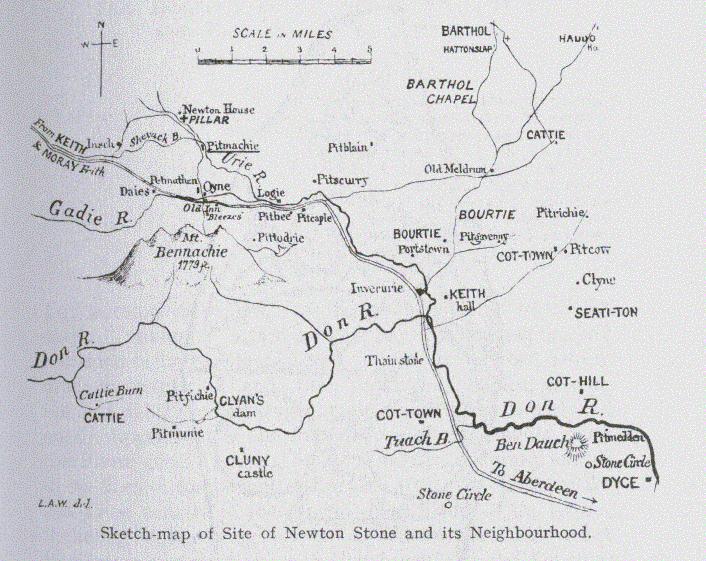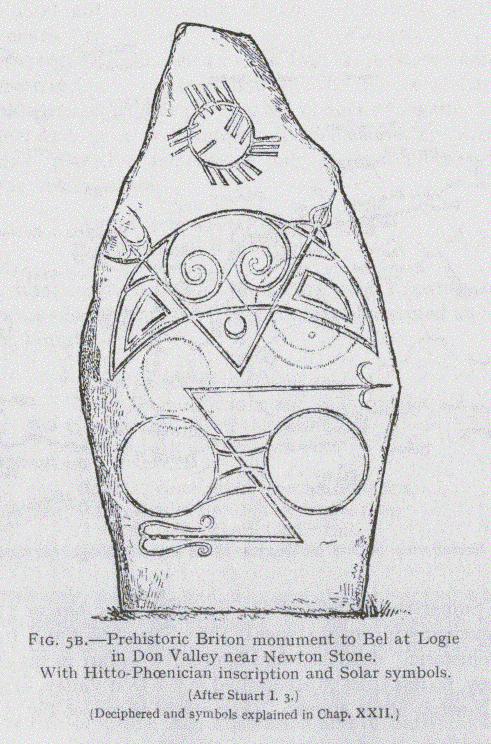
Sketch-map of Site of Newton Stone and its Neighbourhood.
"That exhaustive British sense and perseverance so whimsical in its choice of objects, which leaves its own Stonehenge or Choir Gaur to the rabbits, whilst it opens pyramids and uncovers Nineveh."-EMERSON on "Stonehenge.""We have no first-hand notice of Britannia until Julius Caesar landed there in 55 B.C."-Sir H. E. MAXWELL, 1912.1
THIS uniquely important and hitherto undeciphered inscribed ancient monument (see Frontispiece), bearing a "first-hand notice of Britannia" dating to about 400 B.C., and thus three and a half centuries earlier than Caesar's journal, is now disclosed herein to have been erected by an Aryan-Phoenician Briton king; and it offers us a convenient starting point for our fresh exploration for the lost history of our civilized ancestors-the Britons, Scots and Anglo-Saxons.
The monument now stands at Newton House in the upper valley of the Don in Aberdeenshire (see sketch-map, p.19), whence it derives its common modern name of "The Newton Stone." It has been known since 1803, by the opening up of a new road in its neighbourhood, as an antiquarian curiosity which has baffled all attempts of the leading experts at the decipherment and translation of its inscriptions.
It appears to be the first Phoenician document yet reported in Britain. Although tradition has credited the Phoenicians with long commercial and industrial intercourse with Cornwall in exploiting its tin and copper mines, and numerous
16
traces of the extensive workings of these mines in "prehistoric" times are still abundantly visible near Penzance and elsewhere in The Duchy-many of which I have personally examined several times-no specific Phoenician inscription seems hitherto to have been reported either in Cornwall or elsewhere in the British Isles. Yet this unique ancient historical monument does not appear to be under the protection of the Ancient Monuments Act.
The following description of this rude stone pillar and its site and environments embodies the results of my personal examination of the monument itself and its neighbourhood, supplemented by local enquiry and the chief published references to the stone.
Its former, and presumably its original site where it stood before its removal to its present site about 1836, was recorded from personal knowledge by the famous archaeologist Prof. J. Stuart as being at (see sketch-map):-
"a spot surrounded by a wood close to the present toll-gate of Shevack, about a mile south of the House of Newton. From its proximity to the Inn and Farm of Pitmachie it has occasionally been called the Pitmachie Stone. When the ground on which it stood was in course of being trenched several graves were discovered on a sandy ridge near the stone . . . graves made in hard gravel without any appearance of flags at sides or elsewhere."1 This information was supplemented by the late Lord Aberdeen, who wrote that the Stone originally stood on an open moor . . . a few paces distant from the high road near Pitmachie turnpike of the Great Northern Road recently opened, the old road having been on the opposite side of the Gady."2
The spot, thus indicated (see sketch-map) by these authentic contemporary records, stands in the heart of a romantic meadow encircled by picturesque hills and dominated by the beetling crags of Mt. Bennachie, crowned with the ruins of a prehistoric fort, rising on the west. It is within the angle of the old moorland meadow (now part of the richly cultivated Garrioch vale of old Pict-land) between the Shevack stream and the Gadie rivulet, which latter formerly,
before the accumulation of silt, may have joined hereabouts with the Shevack and Urie tributaries of the Don.
This "Gadie" name for this vigorous rivulet, half encircling the Bennachie range, and in the direct line of the lower Don Valley, is highly suggestive of Phoenician influence, as we shall find that the Phoenicians usually spelt their tribal name of "Khatti" or "Catti" as " Gad," and were in the habit not infrequently of calling the rivers at their settlements "Gadi," or "Gad-es," or "Kad-esh."
This romantic Gadie glen of the Don, sequestered among the green groves and overhung by the purple slopes of the bold Bennachie, was presumably of ancient repute, as it is celebrated in a well-known old Scottish song with a haunting plaintive melody of ancient anonymous origin and the refrain:-
"O gin I were where Gadie rins, At the back o' Ben-each-ie."In its stanzas, given by Dr. John Park over a century ago, it appears almost as if the Gadie contained a sacred ancient site of burial:-
"O gin I were where Gadie rins
Mang fragrant heaths and yellow whins,
Or brawling down the bosky linns,
At the back o' Ben-nach-ie.
O aince, aince mair, where Gadie rins,
Where Gadie rins, where Gadie rins,
O micht I dee where Gadie rins
At the back o' Ben-each-ie."
And this vale, we shall find, was probably the actual site of the traditional sacred cemetery of the prehistoric royal erector of this monument that is celebrated in the early chronicles of the Irish Scots.1
The prehistoric antiquity of this district of the Don Valley as a
centre of Stone Age habitation and of Early Civilization for the north
of Britain is evidenced by its richness in
1 BOI., 81f.
Stone Age implements and in "prehistoric" sculptured stones in the neighbourhood, with several Stone Circles1 - the so-called "Druid" Circles, but which, as we shall see, were solar observatories of the Phoenicians and Early Goths, and essentially non-Druidical and anti-Druidical. So rich indeed is this Don Valley district in "prehistoric" sculptured monuments, most of which, I find, bear Phoenician

Sketch-map of Site of Newton Stone and its Neighbourhood.
and Sumerian symbols of the Sun-cult, that out of 150 of the ancient sculptured stones in the whole of Scotland, mostly "prehistoric" described and figured by Stuart in his classic survey, no less than 36 are located in the Don Valley, in which the Newton Stone stands. (For one of them see Fig. 5B.)
The stone is an elongated, somewhat irregular, unworked, natural slab of boulder formation, of closely-grained quartzose gneiss, like other boulders lying on the surface in its neighbourhood. It stands about six and a half feet above the ground, and is about two feet broad. It bears inscriptions in two different kinds of script. These inscriptions now claim our notice.
